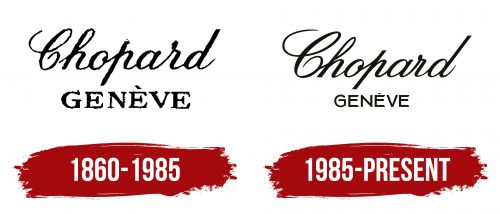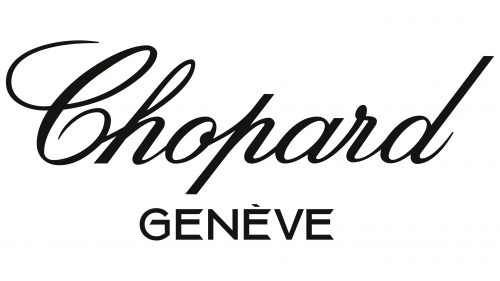The Chopard logo embodies elegance and refined beauty. The unique design of the inscription highlights the brand’s approach and commitment to creating original jewelry that harmoniously complements the image of affluent and respectable clients. Every detail of the emblem reflects the status and prestige of the brand, which aligns with its products’ high quality and impeccable style.
Chopard: Brand overview
Chopard’s history begins in the small Swiss town of Sonvilier in the canton of Bern around 1860. Louis-Ulysse Chopard, a talented young watchmaker, founded his workshop there. Born into a farming family, Louis Ulysse developed an early interest in watches and precision mechanics. His passion for creating highly accurate watch movements became the foundation for the company’s future direction.
In its early years, the workshop focused on producing clocks and pocket watches. Louis Ulysse quickly gained a reputation as a master of reliable and precise timepieces. His creations stood out not only for their accuracy but also for their elegant designs, attracting both collectors and general customers.
In the 1880s, Swiss railways began purchasing watches from the company, recognizing the quality and reliability of the brand’s products. This marked a turning point in the company’s growth and solidified its reputation as a producer of fine timepieces. By the turn of the 20th century, the company was regarded as one of Switzerland’s top makers of clocks and pocket watches. It continued to grow, expanding its offerings and refining its processes. Following trends, the brand began producing wristwatches in the 1920s.
After Louis Ulysse died in 1915, his son Paul-Louis took over the business. Under his leadership, the company maintained its commitment to quality and innovation. In 1937, the workshop moved to Geneva, bringing it closer to its international clients and expanding its market reach.
The 1960s marked a major shift in the company’s history. With no heirs interested in taking over, Paul-André, the founder’s grandson, decided to sell the business in 1963. The buyer was Karl Scheufele, a member of a German family renowned for its jewelry-making expertise.
Under the Scheufele family’s leadership, the brand entered a new chapter. Karl Scheufele and his son, Karl-Friedrich, revitalized the company while preserving its core values. In addition to watchmaking, the business began focusing heavily on jewelry.
One of the company’s most iconic creations, the Happy Diamonds watch, was introduced in 1974. This model, featuring free-moving diamonds encased between two sapphire crystals, was groundbreaking in watch and jewelry design. The concept of “dancing diamonds” became a signature and appeared in many collections.
In the 1980s, the company expanded its focus on sports watches. 1988, it became the official timekeeper for the famous Mille Miglia race. This collaboration inspired the Mille Miglia collection, which became one of the brand’s most popular lines.
Throughout the 1990s, the business continued to grow internationally and explore new directions. In 1996, it strengthened its position as a high-end watchmaker by producing its movements at a newly opened facility in Fleurier.
1998, the company partnered with the Cannes Film Festival, increasing its visibility. This collaboration led to creating the Red Carpet collection, featured at the festival each year.
In the early 2000s, the company’s watchmaking capabilities advanced further. In 2001, the company launched its first in-house movement, the L.U.C 1.96 calibre, named after the founder. This milestone reinforced its reputation as a luxury watchmaker.
The business celebrated its 150th anniversary in 2010 by releasing special commemorative collections. That same year, it expanded its manufacturing capacity by opening a new facility in Geneva.
The company refined its jewelry and watchmaking lines in the following years, regularly introducing new collections combining modern technology and traditional craftsmanship. The focus remained on producing complex watch mechanisms and unique jewelry pieces.
The 2013 Green Carpet high jewelry collection launch was a notable initiative in its jewelry line.
By 2023, the company had established itself as a leading producer of luxury jewelry and watches worldwide. Remaining a family-run business under the Scheufele family, it has retained its unique identity and independence in decision-making.
The brand’s history is a family business story that grew from a small watchmaking workshop to an internationally recognized name. For over 160 years, the company has adapted to changing market demands while staying true to the founder’s traditions of quality and innovation. Today, it continues to impress with its unique designs that masterfully combine the art of fine jewelry and watchmaking.
Meaning and History
What is Chopard?
This Swiss company masterfully combines the art of jewelry making with fine watchmaking. As a family business, the brand has earned a solid reputation for creating stunning jewelry and watches, often blending both industries in innovative designs. The brand’s watchmaking expertise is showcased in the L.U.C series, known for its complex and high-quality in-house movements. Their Happy Diamonds concept has become iconic in jewelry and watches, where diamonds move freely between two sapphire crystals. The brand has strengthened its position in the luxury market by closely connecting with the film industry, including a partnership with the Cannes Film Festival.
1860 – 1985
The Chopard emblem is based on a script font, giving the brand uniqueness and connecting it to the company’s founder, Louis-Ulysse Chopard. Each piece reflects the creator’s imagination and ideas, so the surname is written in cursive on the logo. This adds individual characteristics and emphasizes the personal connection to the author.
Beneath this inscription, the capital of Switzerland, Geneva, is written in large letters. This decision helps to associate the brand with the prestige and global status of the city, even though the company was originally founded in Sonvilier, another canton of Switzerland. It was not until 1937 that the production was moved to Geneva.
The equal size of both parts of the logo symbolizes two key aspects of the brand: the creator and his homeland, reflecting the harmony between personal heritage and the country of origin.
1985 – today
After expanding production, Karl Scheufele III updated the logo, adding even more elegance, purity, and refinement. While remaining in its original cursive form, the founder’s surname acquired smoother, more rounded lines, highlighting the brand’s renowned grace. These changes made the logo visually lighter, which also reflects the brand’s philosophy—the pursuit of the perfect balance between sophistication and modernity.
The font for the word “Geneva” also changed: it became more refined and smaller, with a sans-serif style chosen to emphasize the brand’s modern character. This move gave the visual emblem a fresh and elegant look, and the absence of heavy details made it easier to perceive while highlighting the brand’s effort to keep up with the times while preserving its traditions.
In the updated version, the emphasis is placed on the brand name, and the stylish, minimalist font underscores its prestige and exclusivity. The entire logo aesthetic embodies the brand’s pursuit of perfection, reflecting the luxury and sophistication of the jewelry with which the brand is consistently associated. This enables the brand to continue symbolizing high quality, refinement, and unparalleled craftsmanship without losing its uniqueness in the modern market.






